
Marc Quinn is a British contemporary visual artist whose work includes sculpture, installation, and painting. Quinn explores "what it is to be human in the world today" through subjects including the body, genetics, identity, environment, and the media. His work has used materials that vary widely, from blood, bread and flowers, to marble and stainless steel. Quinn has been the subject of solo exhibitions at Sir John Soane's Museum, the Tate Gallery, National Portrait Gallery, Fondation Beyeler, Fondazione Prada, and South London Gallery. The artist was a notable member of the Young British Artists movement.
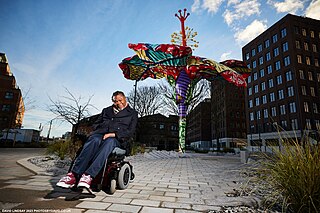
Yinka Shonibare, is a British-Nigerian artist living in the United Kingdom. His work explores cultural identity, colonialism and post-colonialism within the contemporary context of globalisation. A hallmark of his art is the brightly coloured Ankara fabric he uses. As Shonibare is paralysed on one side of his body, he uses assistants to make works under his direction.
John Byrne is an Irish artist born in Belfast, Northern Ireland, now living and working in Dublin.
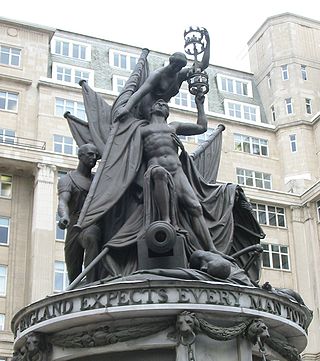
The Nelson Monument is a monument to Admiral Horatio Nelson, in Exchange Flags, Liverpool, England. It was designed by Matthew Cotes Wyatt and sculpted by Richard Westmacott. It stands to the north of the Town Hall and was unveiled in 1813.
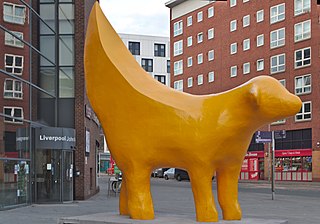
Superlambanana is a bright yellow sculpture in Liverpool, England. Weighing almost 8 tonnes and standing at 5.2 metres tall, it is intended to be a cross between a banana and a lamb and was designed by New York City-based Japanese artist Taro Chiezo. It currently stands in Tithebarn Street, outside the Avril Robarts Library of Liverpool John Moores University, having previously been located on Wapping near the Albert Dock.
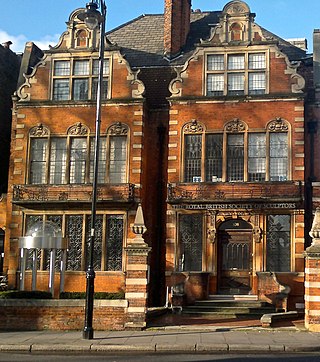
The Royal Society of Sculptors (RSS) is a British charity established in 1905, which promotes excellence in the art and practice of sculpture. Its headquarters are a centre for contemporary sculpture on Old Brompton Road in South Kensington, London. It is the oldest and largest organisation dedicated to sculpture in the UK. Until 2017, it was known as the Royal British Society of Sculptors.
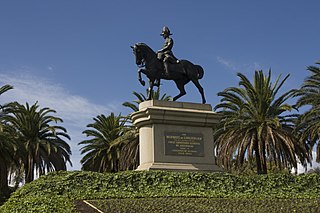
William Birnie Rhind RSA (1853–1933) was a Scottish sculptor.

The fourth plinth is the northwest plinth in Trafalgar Square in central London. It was originally intended to hold an equestrian statue of William IV, but remained empty due to lack of funds. For over 150 years, its use was debated; in 1998, the Royal Society for the encouragement of Arts, Manufactures and Commerce (RSA) commissioned three contemporary sculptures to be displayed temporarily on the plinth. Shortly afterwards, Chris Smith, Secretary of State for Culture, Media and Sport, commissioned Sir John Mortimer to seek opinions from public art commissioners, critics and members of the public as to its future. Mortimer's final report recommended that there continue to be a rolling programme of commissioned temporary artworks rather than settle permanently on one figure or idea.

Ben Moore is a British art curator, entrepreneur and artist. He is the founder and curator of Art Below, a contemporary art organisation that places art in public spaces and has had shows in England, Germany, Japan and the United States. He is also the founder and curator of Art Wars, an exhibition of designs based on the Imperial Stormtrooper helmets from Star Wars. In 2021, Moore was part of the Art Wars NFT project which resulted in massive losses for the purchasers of the NFTs and claims of copyright theft from artists whose physical work was reproduced without their permission.

Boadicea and Her Daughters is a bronze sculptural group in London representing Boudica, queen of the Celtic Iceni tribe, who led an uprising in Roman Britain. It is located to the north side of the western end of Westminster Bridge, near Portcullis House and Westminster Pier, facing Big Ben and the Palace of Westminster across the road. It is considered the magnum opus of its sculptor, the English artist and engineer Thomas Thornycroft. Thornycroft worked on it from 1856 until shortly before his death in 1885, sometimes assisted by his son William Hamo Thornycroft, but it was not erected in its current position until 1902.

Paternoster, also known as Shepherd and Sheep or Shepherd with his Flock, is an outdoor bronze sculpture of 1975 by Elisabeth Frink, installed in Paternoster Square near St Paul's Cathedral in London, United Kingdom.
Anthony James Heaton OBE is a British sculptor, disability rights activist and arts administrator, who was appointed an OBE in 2013 for services to the arts and the disability arts movement. He was CEO of the arts charity Shape until March 2017. In 2012, he won the competition to produce an installation celebrating Channel 4's involvement in the London 2012 Paralympic Games. This produced his 'Monument for the Unintended Performer'.
Sam Shendi is an Egyptian-born, British sculptor. He uses contemporary industrial material, steel, stainless steel, aluminium and fibreglass to create his figurative work. He lives and works in North Yorkshire.

A Surge of Power 2020 is a 2020 black resin sculpture, sculpted by Marc Quinn and modelled on Jen Reid; both Quinn and Reid are credited as artists. It depicts Reid, a black female protester, raising her arm in a Black Power salute. It was erected surreptitiously in the city centre of Bristol, England, in the early morning of 15 July 2020. It was placed on the empty plinth from which a 19th-century statue of Edward Colston, who had been involved in the Atlantic slave trade, had been toppled, defaced and pushed into the city's harbour by George Floyd protesters the previous month. The statue was removed by Bristol City Council the day after it was installed.
The year 2022 in art involves various significant events.
The End is a sculpture by British artist Heather Phillipson, which was installed on the fourth plinth at Trafalgar Square, London, from 2020 to 2022. The sculpture depicted a gigantic dollop of melting whipped cream, topped with a cherry, with a fly and a functioning drone scaling its surface. The drone was fitted with a camera, which sent a live feed of the surrounding area to a dedicated website. Standing 9.4 metres (31 ft) in height, the sculpture was the tallest installation to date as part of the Mayor of London's Fourth Plinth Programme, which features a rolling commission of public artworks.














